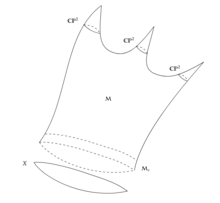Donaldson's theorem
In mathematics, and especially gauge theory, Donaldson's theorem states that a definite intersection form of a compact, oriented, simply connected, smooth manifold of dimension 4 is diagonalisable. If the intersection form is positive (negative) definite, it can be diagonalized to the identity matrix (negative identity matrix) over the integers.
History
The theorem was proved by Simon Donaldson. This was a contribution cited for his Fields medal in 1986.
Idea of proof
Donaldson's proof utilizes the moduli space of solutions to the anti-self-duality equations on a principal -bundle over the four-manifold. By the Atiyah-Singer index theorem, the dimension of the moduli space is given by
where , is the first Betti number of and is the dimension of the positive-definite subspace of with respect to the intersection form. When is simply-connected with definite intersection form, possibly after changing orientation, one always has and . Thus taking any principal -bundle with , one obtains a moduli space of dimension five.

This moduli space is non-compact and generically smooth, with singularities occurring only at the points corresponding to reducible connections, of which there are exactly many.[1] Results of Clifford Taubes and Karen Uhlenbeck show that whilst is non-compact, its structure at infinity can be readily described.[2][3][4] Namely, there is an open subset of , say , such that for sufficiently small choices of parameter , there is a diffeomorphism
- .
The work of Taubes and Uhlenbeck essentially concerns constructing sequences of ASD connections on the four-manifold with curvature becoming infinitely concentrated at any given single point . For each such point, in the limit one obtains a unique singular ASD connection, which becomes a well-defined smooth ASD connection at that point using Uhlenbeck's removable singularity theorem.[4][1]
Donaldson observed that the singular points in the interior of corresponding to reducible connections could also be described: they looked like cones over the complex projective plane , with its orientation reversed.
It is thus possible to compactify the moduli space as follows: First, cut off each cone at a reducible singularity and glue in a copy of . Secondly, glue in a copy of itself at infinity. The resulting space is a cobordism between and a disjoint union of copies of with its orientation reversed. The intersection form of a four-manifold is a cobordism invariant up to isomorphism of quadratic forms, from which one concludes the intersection form of is diagonalisable.
Extensions
Michael Freedman had previously shown that any unimodular symmetric bilinear form is realized as the intersection form of some closed, oriented four-manifold. Combining this result with the Serre classification theorem and Donaldson's theorem, several interesting results can be seen:
1) Any non-diagonalizable intersection form gives rise to a four-dimensional topological manifold with no differentiable structure (so cannot be smoothed).
2) Two smooth simply-connected 4-manifolds are homeomorphic, if and only if, their intersection forms have the same rank, signature, and parity.
See also
- Unimodular lattice
- Donaldson theory
- Yang-Mills equations
Notes
- Donaldson, S. K. (1983). An application of gauge theory to four-dimensional topology. Journal of Differential Geometry, 18(2), 279-315.
- Taubes, C. H. (1982). Self-dual Yang-Mills connections on non-self-dual 4-manifolds. Journal of Differential Geometry, 17(1), 139-170.
- Uhlenbeck, K. K. (1982). Connections withL p bounds on curvature. Communications in Mathematical Physics, 83(1), 31-42.
- Uhlenbeck, K. K. (1982). Removable singularities in Yang-Mills fields. Communications in Mathematical Physics, 83(1), 11-29.
References
- Donaldson, S. K. (1983), "An application of gauge theory to four-dimensional topology", Journal of Differential Geometry, 18 (2): 279–315, doi:10.4310/jdg/1214437665, MR 0710056, Zbl 0507.57010
- Donaldson, S. K.; Kronheimer, P. B. (1990), The Geometry of Four-Manifolds, Oxford Mathematical Monographs, ISBN 0-19-850269-9
- Freed, D. S.; Uhlenbeck, K. (1984), Instantons and Four-Manifolds, Springer
- Freedman, M.; Quinn, F. (1990), Topology of 4-Manifolds, Princeton University Press
- Scorpan, A. (2005), The Wild World of 4-Manifolds, American Mathematical Society